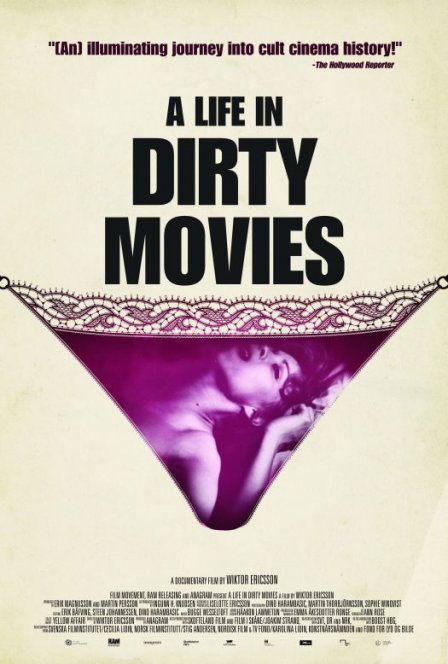Joe Sarno wrote scripts for his porno films. Not merely treatments or outlines, but full shooting scripts for each feature he directed — IMDb lists over 100 titles. His body of work, often regarded as “artsy” and more emotionally interesting than traditional porn, has resulted in him becoming one of the few creators of pornography who has been critically-approved by cinephiles. A Life in Dirty Movies, a documentary on Sarno and his films, first introduces the 88-year old in his office, surrounded by old pornographic DVDs and VHS tapes, typing away on an archaic word processor. A legal pad full of detailed notes and doodles of sexual positions, relevant to the corresponding scene in the notes, lies next to him.
Director Wiktor Ericsson follows Sarno as he struggles to get his latest project made. In an environment and period in which so much erotic content is free (or consumed illegally), it is difficult to acquire the necessary funding for his kind of porn film. Yet Sarno charges on, finalizing his script and meeting with producers about casting. Intercut throughout is a retrospective on his early films from the 60s and 70s and a portrait of his relationship with his supportive wife Peggy.
Sometimes called “the Bergman of 42nd street,” Sarno took summer vacations in Sweden for much of his life and even made some films there. The impact of cinema — particularly Swedish — on his films is notable, and the comparisons to Bergman are more than just a humorous marketing claim to help sell his films. While Bergman’s films often contain an underlying, repressed sexuality, Sarno’s tend to be more upfront and, of course, willing to showcase the sex.
Richly shot in black and white, Sarno’s films often focused on the female psyche and occasionally left the viewer feeling disturbed or depressed. A notable example included in this documentary is a scene from Abigail Lesley Is Back in Town in which a woman, aroused from watching a sex act, masturbates alone on a bed. By the time she reaches climax, she is in tears. This sort of emotional content, a subversion of the eroticism within pornography, reveals Sarno’s preference for undermining traditional porn expectations. Although he often filmed unsimulated sex scenes, he rarely showed penetration. Even in scenes of unsimulated oral sex, genitals are obscured from view. Instead, Sarno preferred to focus on the actresses’ faces. Here, orgasms are rendered through the women’s expressions, breathing and sounds. This results in a more active and imaginative participation in the scene by the audience.
Despite how forward thinking his early films are, Sarno had trouble adapting. He began making hardcore films in the 80s, but was left incredibly unhappy and unfulfilled. Now, utilizing the appreciation and regard his films have acquired, he looks to return to the softcore of his roots. From the beginning it’s a long shot, that this nearly ninety-year old will be able to get his type of movie off the ground for production, let alone distribution. The landscape has changed too much, and this man (who still uses phone booths in his scripts, for which Peggy chastises him) has been left behind. But Sarno comes across as blissfully ignorant, happily content to — and intent on — developing films his own way.
Joe’s films sparkle with a humanity that most exploitation films lack, so it is only fitting that A Life in Dirty Movies is a remarkably human portrait of the man and his wife. By mainly telling the story through Peggy’s eyes, her love for him is brought to the foreground. The scenes depicting this love are alternately charming and maddeningly sad. (Take, for instance, the scene in which Peggy is paying bills online, keeping their financial woes hidden from Joe.)
The documentary was originally titled The Sarnos: A Life in Dirty Movies, before settling on the more economic (both in terms of poster space and ease to market) abbreviated form. But the original title is actually more appropriate for the film, which is as much a portrait of the woman behind the man as it is about the man himself. Not only the subject of his sexual desire, Peggy was also his editor, collaborator, investor, and muse. Her devotion for him mirrors his own passion for his films, and is the doc’s most emotionally resonant content.
I’ll leave you with my favorite scene from the film, emblematic of the themes of devotion and renown that whisper throughout the entire documentary. Shortly following Joe’s death, Peggy unfolds a copy of his obituary that she carries around with her everywhere. She grins widely, speaking with equal parts pride, admiration and affection: “Look how big it is! In the New York Times — famous, like everyone else.”
A Life in Dirty Movies screens Sept 19-26th at Anthology Film Archives in New York.

